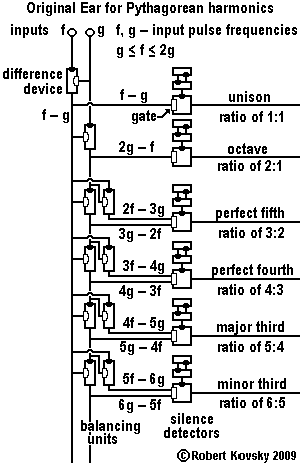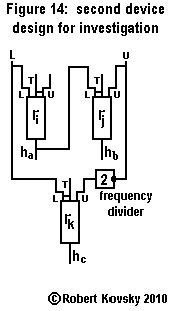

|

|

|

|

|

|

|

|

|

|

|

|

|
| Table of limit values for
ξab = | hc - (ha x hb) |, where c = a + b and (ha x hb) < 2. | |||||||||||||||
|---|---|---|---|---|---|---|---|---|---|---|---|---|---|---|---|
| index | || | 0 | 1 | 2 | 3 | 4 | 5 | 6 | 7 | 8 | 9 | 10 | 11 | 12 | |
| hindex | || | 1 | 16/15 | 9/8 | 6/5 | 5/4 | 4/3 | 7/5 | 3/2 | 8/5 | 5/3 | 7/4
9/5 | 15/8 | 2 | |
|
— — — — — — — — — — — — — — — — — — —
| |||||||||||||||
| 0 | 1 | | | 0 | 0 | 0 | 0 | 0 | 0 | 0 | 0 | 0 | 0 | 0 | 0 | 0 |
| 1 | 16/15 | | | 0 | 0.013 | 0 | 0.030 | 0 | 0.022 | 0.007 | 0 | 0.040 | 0.023 | 0.008 | 0 | |
| 2 | 9/8 | | | 0 | 0 | 0.016 | 0.017 | 0.006 | 0 | 0.025 | 0.021 | 0 | 0 | |||
| 3 | 6/5 | | | 0 | 0.030 | 0.017 | 0.040 | 0 | 0 | 0.013 | 0 | 0.045 | 0 | |||
| 4 | 5/4 | | | 0 | 0 | 0.006 | 0 | 0.038 | 0 | 0 | 0 | 0 | ||||
| 5 | 4/3 | | | 0 | 0.022 | 0 | 0 | 0 | 0.023 | 0.008 | 0 | |||||
| 6 | 7/5 | | | 0 | 0.007 | 0.025 | 0.013 | 0 | 0.008 | 0.040 | ||||||
| 7 | 3/2 | | | 0 | 0 | 0.021 | 0 | 0 | 0 | |||||||
| 8 | 8/5 | | | 0 | 0.040 | 0 | 0.045 | 0 | ||||||||
| 9 | 5/3 | | | 0 | 0.023 | 0 | 0 | |||||||||
| 10 | 7/4 9/5 | | | 0 | 0.008 | |||||||||||
| 11 | 15/8 | | | 0 | 0 | |||||||||||
| 12 | 2 | | | 0 | ||||||||||||

|
| Combined table of values for
ξab = | hc - (ha x hb) |, where c = a + b and (ha x hb) < 2; and ξab = | hc - ½ (ha x hb) |, where c = a + b and (ha x hb) > 2. | |||||||||||||||
|---|---|---|---|---|---|---|---|---|---|---|---|---|---|---|---|
| index | || | 0 | 1 | 2 | 3 | 4 | 5 | 6 | 7 | 8 | 9 | 10 | 11 | 12 | |
| hindex | || | 1 | 16/15 | 9/8 | 6/5 | 5/4 | 4/3 | 7/5 | 3/2 | 8/5 | 5/3 | 7/4
9/5 | 15/8 | 2 | |
|
— — — — — — — — — — — — — — — — — — —
| |||||||||||||||
| 0 | 1 | | | 0 | 0 | 0 | 0 | 0 | 0 | 0 | 0 | 0 | 0 | 0 | 0 | 0 |
| 1 | 16/15 | | | 0 | 0.013 | 0 | 0.030 | 0 | 0.022 | 0.007 | 0 | 0.040 | 0.023 | 0.008 | 0 | 0 |
| 2 | 9/8 | | | 0 | 0 | 0.016 | 0.017 | 0.006 | 0 | 0.025 | 0.021 | 0 | 0 | 0.012 | 0.012 | 0 |
| 3 | 6/5 | | | 0 | 0.030 | 0.017 | 0.040 | 0 | 0 | 0.013 | 0 | 0.045 | 0 | 0.013 | 0 | 0 |
| 4 | 5/4 | | | 0 | 0 | 0.006 | 0 | 0.038 | 0 | 0 | 0 | 0 | 0.025 | 0 | 0.028 | 0 |
| 5 | 4/3 | | | 0 | 0.022 | 0 | 0 | 0 | 0.023 | 0.008 | 0 | 0 | 0.014 | 0 | 0 | 0 |
| 6 | 7/5 | | | 0 | 0.007 | 0.025 | 0.013 | 0 | 0.008 | 0.040 | 0.017 | 0.005 | 0.033 | 0.010 | 0.021 | 0 |
| 7 | 3/2 | | | 0 | 0 | 0.021 | 0 | 0 | 0 | 0.017 | 0 | 0 | 0 | 0.017 | 0.006 | 0 |
| 8 | 8/5 | | | 0 | 0.040 | 0 | 0.045 | 0 | 0 | 0.005 | 0 | 0.030 | 0 | 0 | 0 | 0 |
| 9 | 5/3 | | | 0 | 0.023 | 0 | 0 | 0.025 | 0.014 | 0.033 | 0 | 0 | 0.011 | 0 | 0.038 | 0 |
| 10 | 7/4 9/5 | | | 0 | 0.008 | 0.012 | 0.013 | 0 | 0 | 0.010 | 0.017 | 0 | 0 | 0.020 | 0.021 | 0 |
| 11 | 15/8 | | | 0 | 0 | 0.012 | 0 | 0.028 | 0 | 0.021 | 0.006 | 0 | 0.038 | 0.021 | 0.008 | 0 |
| 12 | 2 | | | 0 | 0 | 0 | 0 | 0 | 0 | 0 | 0 | 0 | 0 | 0 | 0 | 0 |
II. Philosophy of Science
- Quad Nets (2006)-- Quad Nets is the chief engineering and scientific presentation of my "device models of brains." Timing Devices, discussed here, began as a simplified version of the Quad Net Model.
- Quad Nets website -- separately organized web page on the full paper titled Quad Nets: Material Foundations for Thermal Device Models of Brains download Quad Nets paper. (.pdf format, 1.1 Mb)
- Timing Devices (2007-2009) has developed from a simplified version of the Quad Net Model into an independent area of investigation. The course of development includes possible future projects.
- The complete Timing Devices paper is available for download, a .pdf file, 460 kB. Another web page presents the Abstract of the paper and the listing of Contents. The separate website, link, Shimmering Silences in Beautiful Music (2009) presented initial investigations and original constructions that developed into the present Ear for Pythagorean Harmonics, along with an earlier version of the Timing Devices paper, titled An Ear for Pythagorean Harmonics: Mathematical Processing in Brain Models Built From "Timing Devices," (2009), a .pdf file 212 kB. The separate web page, "Timing Devices or Why Brains Are Not Computers," link, is now the setting for the first, 2007, version of the Timing Devices paper, .pdf file, 363 kB. The separate web page, Dancer - Shimmering Gaits of a Six-Legged Engineered Organism link, contains a proposed series of projects for construction of systems for engineered organisms (artificial animals) to be built from timing devices and Quad Net assemblies, starting with a "Utricle" that detects the orientation of an organism with respect to gravity and progressively leading upwards to a six-legged organism that uses a variety of coordination patterns ("gaits") in attempts to navigate a broken and obstructed terrain. See also "Advanced Note: Convolution Timing Devices," a .pdf file (68 kB) link, preparatory for the present Timing Devices paper.
(return to top of page).
- "Brains are computers" is part of a belief system that I call the Mechanical Cosmology and that includes other propositions: "all things are made of atoms" and "the Universe is governed by laws of physics, like the law of conservation of energy." Beliefs about atoms and laws of physics have been developmentally productive and wonderfully fruitful in practical ways – in contrast to "brains are computers" – but they are also false and misleading. There are no "atoms." Atoms are mental constructions and they do not appear in reality. It is possible to buy materials, such as minerals, metals, refined chemical reagents, vegetable materials, animal materials and synthetic materials; but it is not possible to buy "atoms." The material that is closest to "atoms," refined helium, shows complex, collective, "non-atomic" properties when the temperature gets very low and the helium liquifies. Energy is never "conserved." "Conservation of energy" is an ideal that is never attained, although billiard tables, vaccuum chambers and ball bearings rather approach it and make exact calculations possible under some circumstances. Physicists believe that all of reality is made up of particles and laws of physics. Some parts of reality are well modeled by methods based on this belief but other parts of reality – e.g., the reality of persons and the reality of conflicting principles of social organization – cannot even be recognized. The physicists' belief is formed through study of imaginary conservative systems of atoms that can never be realized and that do not apply at all to situations that are most important to persons living their lives. My works on these subjects are not as compactly organized as my engineering and scientific works and the themes run through many diverse works Works related to Philosophy of Science
- Please see a separate web page, "Facts About Snowflakes," about the generation of snowflakes from gaseous water vapor. Snowflakes can be beautifully symmetrical. Physicists are unable to account for this phenomenon because the proposed atomic processes are independent of one another and distant from each spatially. I argue that the attempt to explain the phenomenon by means of atomic processes is a failure. This failure is exemplary of the failures of physics to explain classes of phenomena of phase changes, of which the change from water to ice is the most familiar. I hold that important brain activities are phase changes and outside the reach of the Mechanical Cosmology. A Patchwork of Limits: Physics Viewed From an Indirect Approach (2000), a .pdf file (157 kB), is discussed on a separate web page The paper is a statement of my "alternative view of physics" that includes technical analysis of the thermodynamic critical state, the conceptual basis of Quad Nets. A broad statement of my alternative view accessible to the lay reader, with a critical analysis of conventional physics, is in § 6 of "An Objective Kind of Freedom," an archival paper in the form of a .pdf file (618 kB.). The paper was published online in January of 2005 and the first six sections were foundational of my development of Quad Nets later in the year. "On Cosmological Principles in Natural Science," a .pdf file (23 kB), link, is suggestive of future approaches.
1/29/10 version
- Testimony of Freedom
- A separate website, under development, that establishes scientific and engineering foundations for investigations into social and spiritual matters.
- Embodiment of Freedom
- A separate website that was a prior stage of development, now superseded in large part by Testimony of Freedom. This site contains the Archive of my work that was done prior to May of 2005 and that led up to Quad Nets.